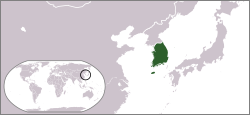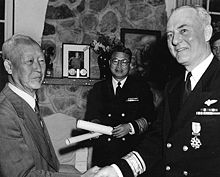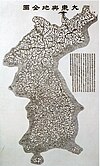
Back جمهورية كوريا الأولى Arabic Primer República de Corea del Sur AST Първа република Южна Корея Bulgarian Primera República de Corea del Sur Spanish Esimene Korea Vabariik Estonian جمهوری اول کره Persian Première République (Corée du Sud) French הרפובליקה הראשונה של קוריאה הדרומית HE कोरिया का पहला गणराज्य Hindi Republik Korea Pertama ID
Republic of Korea 대한민국 大韓民國 | |||||||||
|---|---|---|---|---|---|---|---|---|---|
| 1948–1960 | |||||||||
| Anthem: 애국가 "Aegukga" (1948) "Aegukga" (1948–1960) | |||||||||
| National Seal (1949–1960) | |||||||||
 | |||||||||
| Capital | Seoul (1948–1950, 1952–1960) Busan (1950–1952) | ||||||||
| Common languages | Korean | ||||||||
| Religion | Christianity, Confucianism, Buddhism, Korean Shamanism, Cheondoism | ||||||||
| Government | Unitary presidential republic under an authoritarian dictatorship | ||||||||
| President | |||||||||
• 1948–1960 | Syngman Rhee | ||||||||
| Prime Minister | |||||||||
• 1948–1950 | Lee Beom-seok | ||||||||
• 1950 (acting) | Shin Song-mo | ||||||||
• 1950–1952 | Chang Myon | ||||||||
• 1952 (acting) | Yi Yun-yong | ||||||||
• 1952 | Chang Taek-sang | ||||||||
• 1952–1954 | Paik Too-chin | ||||||||
• 1954 | Pyon Yong-tae | ||||||||
| Vice President | |||||||||
• 1948–1951 | Yi Si-yeong | ||||||||
• 1951–1952 | Kim Seong-su | ||||||||
• 1952–1956 | Ham Tae-young | ||||||||
• 1956–1960 | Chang Myon | ||||||||
| Legislature | National Assembly | ||||||||
| Historical era | Cold War | ||||||||
• Proclamation of the Republic of Korea | 15 August 1948 | ||||||||
| 25 June 1950 – 27 July 1953 | |||||||||
| 19 April 1960 | |||||||||
| Currency | Won (1945–1953) Hwan (1953–1962) | ||||||||
| |||||||||
| Today part of | North Korea South Korea | ||||||||
As Korean Republic | |||||||||
| First Republic of Korea | |
 South Korean President Syngman Rhee bestowing a medal on a U.S. Navy admiral | |
| Korean name | |
|---|---|
| Hangul | 제1공화국 |
| Hanja | 第一共和國 |
| Revised Romanization | Jeil Gonghwaguk |
| McCune–Reischauer | Cheil Konghwaguk |
| History of South Korea |
|---|
 |
|
|
The First Republic of Korea (Korean: 제1공화국; RR: Jeil Gonghwaguk; lit. "First Republic") was the government of South Korea from August 1948 to April 1960. The first republic was founded on 15 August 1948 after the transfer from the United States Army Military Government that governed South Korea since the end of Japanese rule in 1945, becoming the first independent republican government in Korea. Syngman Rhee became the first president of South Korea following the May 1948 general election, and the National Assembly in Seoul promulgated South Korea's first constitution in July, establishing a presidential system of government.
The first republic claimed sovereignty over all of Korea but only controlled Korea south of the 38th parallel until the end of the Korean War in 1953, when the border was modified. The first republic was characterized by Rhee's authoritarianism and corruption, limited economic development, strong anti-communism, and by the late 1950s growing political instability and public opposition to Rhee. The April Revolution in April 1960 led to Rhee's resignation and the transition to the second Republic of Korea.


